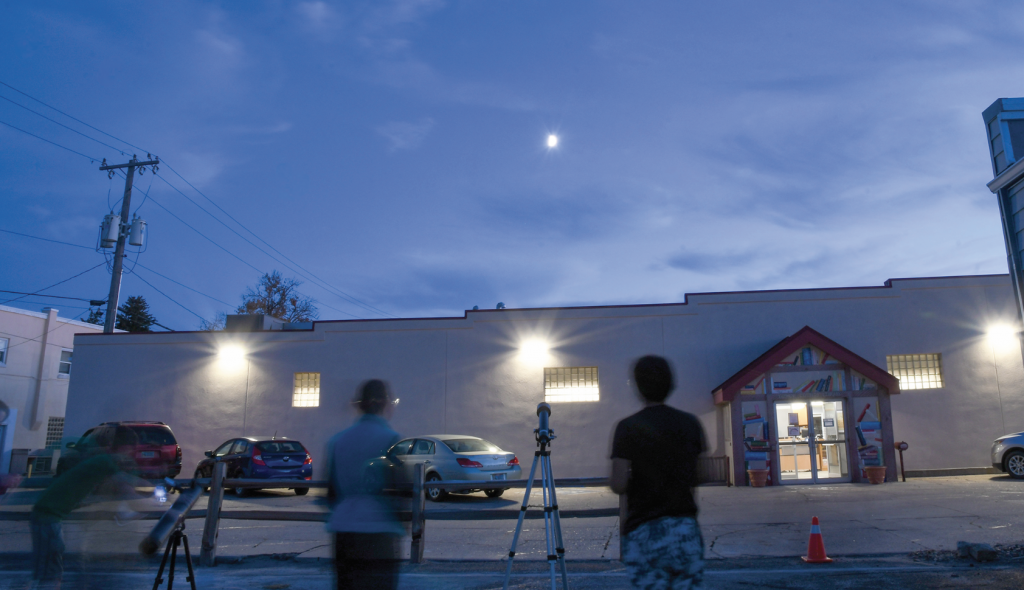
Attendees viewing the moon outside of the Goshen County Library on “International Observe the Moon Night.” Cynthia Sheeley/Torrington Telegram
TORRINGTON – The moon and the night sky have always instilled awe and wonder in those who observe them. By teaching astronomy, adults and children together can be inspired by the unique experience that comes from exploring the universe beyond the Earth’s atmosphere.
In honor of NASA’s “International Observe the Moon Night,” the Goshen County Library hosted an event to observe and learn about the moon on Saturday, Oct. 21. The event included educational content about the moon and its phases, fun activities and outdoor moon gazing.
“I think it’s exciting [to do events like this]” Jessica Anders, Eastern Wyoming College (EWC) librarian and a member of NASA’s Solar System Ambassador’s Program, told the Telegram. “It’s fun to see kids light up when they get that curiosity and make new discoveries [when studying astronomy]; and the adults too.”
Although there were not many families in attendance at the event, the ones who were had fun exploring astronomy together. Each attendee read the different stories Anders provided, which told of several legends of the moon from other cultures. A few of these stories included “Rabbit Moon,” “Moon Woman” and “Fox.”
According to “Rabbit Moon,” a story from the Aztecs of Mexico, “In ancient times, a god chose to set himself on fire and jump into the sky to light the cold, dark world. He became the Sun. A second god, jealous of the praise that the new Sun was getting, did the same.”
“This was too much light and another angry god threw a rabbit at the second Sun’s face to dim his light, making him Moon,” the story continued. That is why there is a dark shadow on the face of the moon that is in the shape of a rabbit.
After reading the stories, everyone was asked to get creative and come up with their own story, with its own characters, about the moon.
“I wrote about a dragon on the moon,” Natalia Closs, one of the children at the event, said. “It wasn’t really about the patterns of the moon but more like the moon phases. The wings cover the moon when she’s upset because she doesn’t want to share the moon.”
Natalia’s sister, Maizie said, “[My story] is about a hamster. It uses the moon as a wheel to go around the Earth.”
Next, the families used Oreos to represent the different phases of the moon. They would remove the frosting from the cookie to signify the necessary shadow and light sides of the moon during that phase.
After the activities, all of the attendees got to view the moon through a refraction telescope, an optical telescope and binoculars.
“[At these types of events, the children] learn about new things, in this case, the moon and space, and that’s something that they enjoy,” Danielle Closs said. “It’s always good for them to learn new things or even learn more about something they might already know about.”
Whether the children are homeschooled or attend public school, these events give them a chance to explore interesting subjects that they might not be able to otherwise.
Anders said the Solar System Ambassadors is a volunteer program for NASA. Their goal is to spread the word about NASA, and their different missions and spread the curiosity about space and exploration. She became a member of the program after sending an application and being accepted.
As a member, Anders receives regular emails with different event ideas to teach about NASA within her community.
“[International Observe the Moon Night is an event] about spreading awareness about space and the moon specifically,” Anders said. “It’s co-sponsored by the Lunar Reconnaissance Orbiter Mission. It’s to help keep excitement about space going.”
According to www.space.com, “International Observe the Moon Night” is an annual event that takes place each year in September or October, usually when the moon is in its first quarter phase. The main goal of the event is to unite people from all around the world through lunar science or just simply observation.
During the event, NASA celebrates with moon-themed videos and presentations on a live stream. To view the live stream from Oct. 21, those interested can go to https://moon.nasa.gov/observe-the-moon-night/.
